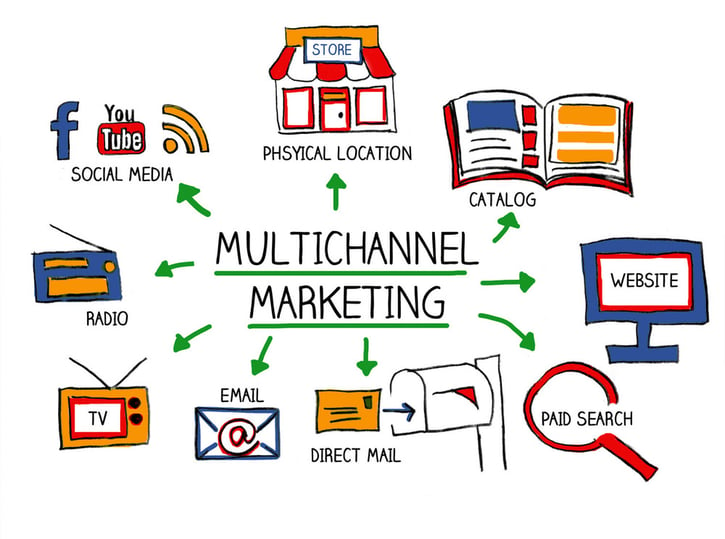Tara is the in-house content lead at Digistorm, tending to all content needs, big or small! When she’s not writing copy or managing the Insights editorial calendar, Tara is passionate about supporting theatre and live music.
- 'Omni-channel' and 'multi-channel' are two current buzz words for marketers
- Omni-channel marketing delivers a seamless and consistent experience across all channels
- Multi-channel marketing executes a marketing strategy across multiple channels
- Omni-channel marketing is a great strategy for schools, and has been found to achieve a 91% higher year-on-year customer retention increase
As marketers, we know that our industry is fast-moving, and with it comes an array of terminology, trends, and "buzz words." One that's caught our attention recently is omni-channel marketing. Have you heard of it?
Basically, omni-channel marketing is a strategy that highlights what we've known for a while about the ever-evolving customer journey: it's no longer linear. In this post, we'll break down what omni-channel marketing is, how it differs from multi-channel marketing, and whether we think it's worth switching up your digital marketing strategy.
What's omni-channel marketing?
Here's what we know: today, marketing is all about creating personalized experiences and communicating with audiences on an individual level through the channels they're already using (and there's a lot!).
So, what's omni-channel marketing? Simply put, it takes marketing personalization and delivers a seamless and consistent experience across all of the channels that a customer uses. You'll notice that we've highlighted seamless and consistent because they really are the key here. A great way to think of it is "walking in your customer's shoes." This quote by John Bowden sums it up nicely.
Omni-channel marketing is viewing the experience through the eyes of your customer, orchestrating the customer experiences across all channels so that it is seamless, integrated and consistent. It anticipates that customers may start in one channel and move to another as they progress to a resolution.
What's multi-channel marketing?
Multi-channel marketing, on the other hand, is pretty much what it sounds like: executing a marketing strategy across multiple channels. These channels might include social media, email, digital and print advertising, website, reviews, and everything in between!
Rather than taking a holistic communication approach, the goal for multi-channel marketing is to communicate a specific message through a variety of channels. That's not to say that multi-channel marketing isn't effective, but there tends to be a greater focus on the brand and channel, rather than the customer and their experience.

Source: FinancesOnline
Which approach should I use?
It's hard to say whether one is better than the other — the marketing strategy you choose to adopt needs to be in line with your school's specific business goals and objectives. While measurement and attribution might be a little easier with a multi-channel approach, research shows that a well-defined omni-channel strategy can achieve a 91% higher year-on-year increase in customer retention.
Now, that's an impressive statistic, but it doesn't come as a huge surprise. Building strong branding and consistency is essential to creating long-lasting customer relationships. Combined with the emphasis on creating more personalized experiences throughout the customer journey, in our humble opinion, omni-channel marketing takes the lead.
How can your school leverage omni-channel marketing?
As it turns out, we're not the only ones who are big fans of the omni-channel approach. In fact, Hubspot recently posted 12 examples of brands that are nailing omni-channel marketing, including some big names like Disney and Starbucks. If you're interested in adopting an omni-channel marketing strategy in 2020, keep these three points in mind...
1. Choose your channels
First up, you'll want to choose which marketing channels your school is going to leverage. At Digistorm, we wholeheartedly believe in quality over quantity — we focus on channels that work for our audience and strive to do them well. For us, this includes our blog, social media (you can follow us on Facebook, LinkedIn, and Twitter), email, and our website just to name a few. Remember, no matter which marketing channels you choose, it's essential to be deliberate, in touch with where your prospective parents prefer to communicate, and of course, don't spread your resources too thin. Focus on a few key channels and nail them!
2. Define your message
Now that you know which channels you're going to leverage to communicate with your audience, it's time to define your message. If you haven't already, we recommend starting by identifying your school's USP. Think of your USP just like an elevator pitch — it's a quick, clear, and succinct answer to what makes your school special and why it should be the school of choice for prospective parents.
3. Maintain consistency
Creating a seamless experience for prospective parents across all of your marketing channels comes down to consistency. This means taking a holistic approach with your communication and ensuring that your prospective parents receive a great experience, no matter which channel they're engaging with. Set some specific brand guidelines for your school's next marketing campaign (considering elements like digital assets, messaging, and tone of voice) and replicate it across all of your marketing channels.
.png)